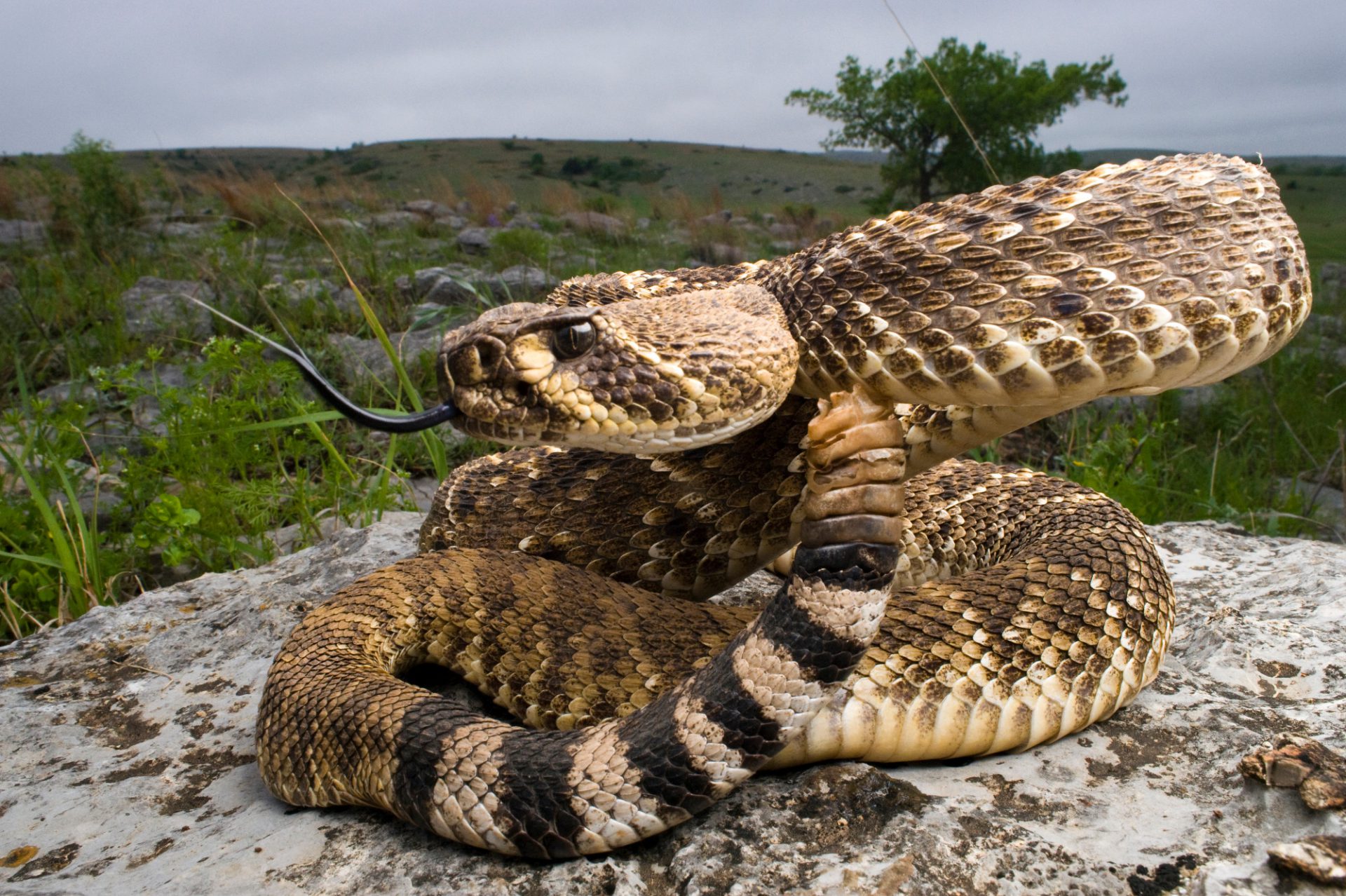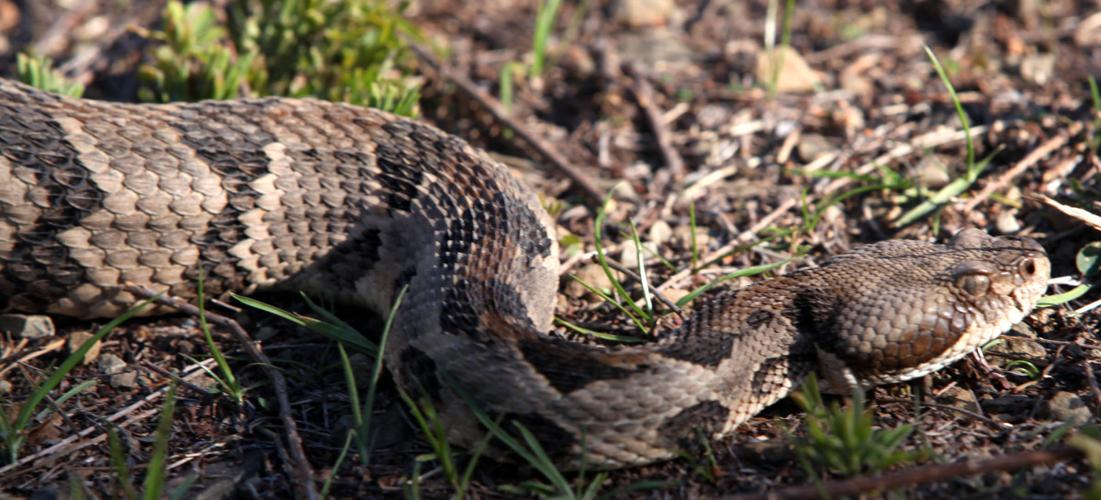Oklahoma is home to a diverse range of wildlife, including 46 different snake species, seven of which are venomous. Among the venomous snakes, there are five different species of rattlesnakes that can be found in Oklahoma.
In this article, we will explore the five types of rattlesnakes that are native to Oklahoma, including their habitats and characteristics. Whether you are a resident of Oklahoma or planning a visit, it is important to be aware of these venomous snakes and how to stay safe in their presence.
You are reading: Discover The 5 Types Of Rattlesnakes In Oklahoma

5 Types Of Rattlesnakes In Oklahoma
Timber Rattlesnake (also known as the Canebrake Rattlesnake)

The Timber Rattlesnake, also known as the Canebrake Rattlesnake, is a large, heavily-bodied pit-viper that can be found in central and southeastern Oklahoma.
These snakes have a distinctive rattle on their tail and a black, velvety colored tail. They have a golden brown body with dark crossbands, and most southern forms have a reddish-orange stripe that runs down the back.
Timber Rattlesnakes usually live in woodland or rocky areas and along streams. They can also be found in lowland thickets and high rocky hillsides.
These snakes are venomous and should be approached with caution. If you encounter a Timber Rattlesnake in the wild, it is best to give it plenty of space and avoid disturbing it.
Western Diamondback Rattlesnake

The Western Diamondback Rattlesnake, also known as the Texas Diamond-back, is a venomous rattlesnake species that belongs to the viper family. It is the most common rattlesnake encountered in the southwestern United States and northern Mexico.
Read more : Types Of Salmon And Their Distinctive Features
These snakes are heavy-bodied with a triangular-shaped head and have two dark diagonal lines on each side of their face. They are pit vipers, which means they have a heat-sensing pit located behind each nostril that can detect differences in temperature.
Western Diamondbacks can grow up to seven feet in length and have a lifespan of approximately 15-20 years in a zoological setting. They are not currently threatened or endangered.
These snakes feed on small mammals such as mice, rats, rabbits, and ground-dwelling birds. Western Diamondbacks are responsible for the majority of snakebite fatalities in northern Mexico and the greatest number of snakebites in the United States.
If you encounter a Western Diamondback Rattlesnake in the wild, it is best to give it plenty of space and avoid disturbing it.
Western Pygmy Rattlesnake
The Western Pygmy Rattlesnake is a small, colorful rattlesnake with a slender tail and tiny rattle. It is one of the smallest species of rattlesnake in North America.
The general color of the Western Pygmy Rattlesnake is brownish-gray with dark blotches down its back and one to three rows of dark spots along each side of the body. The body color is gray or tan with an orangish-brown mid-dorsal stripe usually present.
These snakes have hollow fangs to inject venom into their prey and heat-sensitive pits between the eyes and nostrils that allow them to detect and accurately strike warm-blooded prey such as rodents even in total darkness. Juveniles are known to wave their yellow-tipped tail to lure frogs and lizards close enough to kill and eat.
The Western Pygmy Rattlesnake is found in a variety of habitats, but is usually in close proximity to water. They occur in flood plains, wetlands, and moist fields, and occasionally found in rocky uplands, pine woods, and glades.
In Missouri, the Western Pygmy Rattlesnake is most often observed in or near glades, in second-growth forests near rock ledges, and along the area between forests and open lands.
In Tennessee, they are found around the edges of lakes and swamps. These snakes are venomous, but their bite is not fatal. If you encounter a Western Pygmy Rattlesnake in the wild, it is best to give it plenty of space and avoid disturbing it.
Prairie Rattlesnake
Read more : 4 Types Of Vipers
The Prairie Rattlesnake, also known as the Great Plains Rattlesnake, is a venomous pit viper species native to the western United States, southwestern Canada, and northern Mexico. They are primarily terrestrial, but occasionally climb in trees or bushes and are typically active diurnally in cooler weather and nocturnally during hot weather.
Prairie Rattlesnakes can grow up to five feet long and have a triangular head and body covered in dark blotches which gradually turn into rings as they near the tail. They have a heat-sensitive pit on each side of their head between the nostril and the eye, which allows them to detect heat very well.
Prairie Rattlesnakes are found in North America over much of the Great Plains, the eastern foothills and some intermontane valleys of the Rocky Mountains, from southwestern Canada through the United States to northern Mexico. They inhabit a wide variety of habitats, ranging from prairies to wooded mountains, and are often associated with rocky outcrops or prairie dog towns.
Prairie Rattlesnakes are equipped with powerful venom and will defend themselves if threatened or injured. They feed on small mammals, such as ground squirrels, ground nesting birds, mice, rats, small rabbits, and prairie dogs. If you encounter a Prairie Rattlesnake in the wild, it is best to give it plenty of space and avoid disturbing it.
Western Massasauga
The Western Massasauga, also known as Sistrurus tergeminus, is a venomous rattlesnake species found in the southwestern plains of the United States and northern Mexico. Here are some key facts about the Western Massasauga:
– The Western Massasauga is a pit viper and is venomous.
– It is a medium-sized rattlesnake, growing to less than 25 inches in length.
– The Western Massasauga has a light-brown base color with a row of dark brown blotches.
– It is the smallest rattlesnake in Kansas and one of the smallest in North America.
– The Western Massasauga is found in a variety of habitats, including wet meadows, marshes, and deserts.
– It is characterized by a small pit and a triangular-shaped head.
– The Western Massasauga is considered “Vulnerable” by NatureServe.
– The antivenin CroFab can be used to treat severe envenomations.
If you encounter a Western Massasauga in the wild, it is best to give it plenty of space and avoid disturbing it.
FAQS
1. Are all five types of rattlesnakes in Oklahoma venomous?
Yes, all five types of rattlesnakes in Oklahoma are venomous.
2. What should I do if I encounter a rattlesnake in the wild?
If you encounter a rattlesnake in the wild, it is best to give it plenty of space and avoid disturbing it. Do not attempt to handle or approach the snake, as this can be dangerous.
3. What are the habitats of the five types of rattlesnakes in Oklahoma?
The five types of rattlesnakes in Oklahoma can be found in a variety of habitats, including woodlands, rocky areas, prairies, wetlands, and grasslands.
4. How can I identify the different types of rattlesnakes in Oklahoma?
Each type of rattlesnake in Oklahoma has unique physical characteristics that can help with identification. For example, the Timber Rattlesnake has a distinctive rattle on its tail and a black, velvety colored tail, while the Western Diamondback Rattlesnake has two dark diagonal lines on each side of its face.
5. Are rattlesnake bites in Oklahoma common?
Rattlesnake bites in Oklahoma are relatively rare, but they can be serious if not treated promptly. If you are bitten by a rattlesnake, seek medical attention immediately.
Source: https://petstutorial.com
Category: Animals










